Ian Wright defends Marx’s theory of surplus-value and its claim that human labor is the ultimate cause of economic profit.
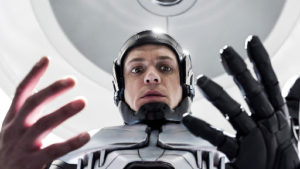
In the topsy-turvy world of capitalist ideology, certain truths must be ignored or repressed because acknowledging them would weaken the rule of capital. One such truth is that human labor, and human labor alone, is the ultimate cause of economic profit. This is anathema to those that merely own assets yet lay claim to the products of labor. So this truth must be denied. Marx’s theory of surplus-value explains how labor is the ultimate cause of profit. And therefore Marx’s theory is ignored, repressed, and denied. In this article, we will consider a popular objection to Marx’s theory of surplus-value, which is that profit is always a joint achievement of human and non-human factors of production, such as machines. According to this objection, human labor is not the unique cause of profit, so Marx’s theory is therefore wrong.
Mainstream economic theory analyses equilibrium states where all factors of production appear to contribute to marginal increases in output: add a bit more capital and get a bit more output. This theory is dominant precisely because it appears to justify the property claims of firm owners on the fruits of others’ labor, even when they contribute no labor or money-capital. The enormously wealthy 1% of rich absentee owners, who reap huge dividends from their equity portfolios while they sleep, wisely allocate a fraction of their wealth to promote such theories.
Capitalist ideology is powerful and pervasive and therefore also affects left-leaning critics of capitalism. Some maintain that Marx’s theory of surplus-value is a quaint Victorian hangover, perhaps appropriate in a time when machines were dumb mechanical contraptions. But now, with advances in Artificial Intelligence, machines are smart and starting to rival our capabilities. And so Marx’s theory of surplus-value, with its focus on the uniqueness of human labor, should be rejected. As we shall see, this denial of the unique causal powers of humans, and the elevation of the machine, is not only incorrect and a complete inversion of social reality. It directly serves the claims of capital, and therefore is inherently reactionary.
Humans vs Machines
According to Marx labor creates value, and nothing else does. In Volume 1 of Capital, he writes: “labour is … the universal value-creating element, and this [is] a property by which it differs from all other commodities”. Human labor is the unique, special factor of production that creates economic value. Yet Marx acknowledges that machines can act autonomously, almost with a will of their own, and perform the same tasks that we do. In the “Fragment on Machines,” Marx writes: “it is the machine which possesses skill and strength in place of the worker, is itself the virtuoso, with a soul of its own in the mechanical laws acting through it”.
Most machines are dumb, lifeless things. A pen that you hold in your hand is a machine, of a kind. It is a system with the causal power to transmit stored ink at a constant rate to its tip. And, obviously, its causal powers are hugely limited compared to what humans can do. But some machines are mechanically powerful; for example, diggers that move tonnes of earth more quickly than any team of humans. And some machines are cognitively powerful, like supercomputers that predict the weather, or neural networks that can translate between languages. Our machines are becoming increasingly sophisticated, replicating and exceeding our physical and mental powers in some domains. In this article, I will use the term “machine” very broadly, to include any non-human system that performs work in a strict thermodynamic sense.
Now, humans don’t produce things on their own. We work with artificial machines and naturally-evolved machines, such as animals and plants. All these systems supply work, which is labor of a kind, to production. The horse that pulls the cart works just as hard as the worker who loads it. Due to these obvious facts, a popular and widespread objection to Marx’s theory of surplus-value is that human labor is not special and therefore cannot be the only factor of production that creates profit.
Let’s begin with the case for humans by briefly revisiting the precise content of Marx’s theory of surplus-value.
Marx’s theory of surplus-value
Marx’s theory of surplus-value explains how capitalism produces more than what’s needed to sustain the population by devoting surplus working time to the production of goods and services for an exploiting class, and also new means of production, such as machinery, which increases the productivity of labor, leading to economic growth, in an unending spiral of capital accumulation. Marx isn’t concerned with explaining profit from market arbitrage, where a trader notices an opportunity to buy low and sell high. This is a zero-sum transfer. What someone gains, another person loses. Buying low and selling high isn’t how economies grow and develop their forces of production. Instead, Marx wants to understand the link between structural changes in the conditions of production, specifically how much labor time is required to produce commodities, and changes in monetary profits. Marx, when presenting the essentials of this theory, assumes that firms use the same techniques of production, that no monopolies exist, that supply and demand are in balance, and so profits aren’t being made due to temporary scarcity, and so on.
The transfer of constant capital
Consider any production process. It has some inputs, which need to be bought on the market, and it has some outputs, which are sold on the market. Workers, during their working day, transform raw materials into new output, aided by tools and machinery. Marx uses the term constant capital to collectively refer to these inputs. Every commodity has a price in the market value and a labor value, which is the quantity of direct and indirect labor needed to produce it. In general, prices do not equal labor values. But in order to abstract from price-value mismatches Marx, in Volume 1, assumes they are proportional.
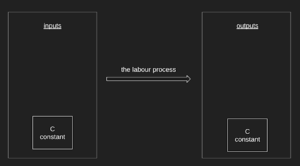
First, Marx states that workers, during the labor process, transfer the value of constant capital to the value of the output. Let’s make this concrete. Imagine you’re a chef in a restaurant chopping up vegetables and frying. The purchase cost of the vegetables reappears as part of the cost of the finished meal on the plate. Your cooking labor transfers this value to the output. Another way of thinking about this is to simply observe that profit-creating labor must always produce an output with a selling price that exceeds the cost of all raw materials that were used up to make it.
Now, some constant capital isn’t completely used up during this process. Every time a worker uses a machine it deteriorates, just a little bit. Machines, unlike the raw materials, aren’t entirely consumed, but persist. For example, the oven in the restaurant heats many meals before it breaks down and requires fixing. Workers, therefore, also transfer the value of fixed machinery — such as ovens, fridges, microwaves, and so on — bit by bit, amortized over multiple outputs, as the machinery depreciates through use.
Yet another way of thinking about this is to simply observe that profit-creating labor must also produce an output with a selling price that covers the cost of running, maintaining, and replacing any machinery. The value of constant capital reappears in the product. And so far, during the working day, the value of the inputs is conserved in the production process. They reappear in the output.
The transfer of variable capital
Marx uses the term variable capital to denote the labor-power that’s employed in a production process. In our restaurant example, the variable capital is the chef, line cooks, waiters, and so on. The value of labor-power is the value of the real wage, which is the direct and indirect labor time needed to produce the goods and services that workers consume. And so workers, during the working day, also transfer the value of the real wage to the output. And therefore both human and non-human costs of production are conserved and reappear in the output.
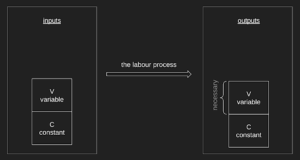
Now, zooming out from the restaurant, imagine this happened in every sector of the economy. The total constant capital is used up and replaced. The total real wage is consumed and replaced. Firms sell their goods in the market and cover their input costs. Workers then get paid sufficient wages to purchase the real wage. In this situation, there are no profits and no growth. The economy just reproduces itself over time at the same scale of production.
Yet this does not happen. There is profit, and there is growth. So where does this profit come from?
Surplus-value
Now we get to Marx’s crucial claim: human labor is special because it’s the only factor of production that adds more value than its own cost. Workers “create value” by working even longer than what’s necessary to replace their real wage. In other words, for profit to be possible the value of the output must be greater than the value of the input. This excess of value, Marx calls surplus-value.
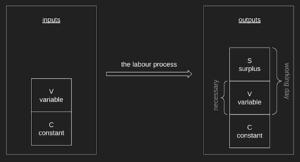
In consequence, the total working day of society has a necessary part, which reproduces the value of the capital stock and the real wage, but also a surplus part, over-and-above what’s necessary, that produces additional goods and services. These additional goods are purchased with profit income, and take the form of luxury goods for capitalists and new capital stock to grow the economy.
So how does human labor actually produce new surplus-value? Basically, in two fundamental ways.
The production of absolute surplus-value
The first way Marx calls the production of absolute surplus-value.
Capitalists can increase their profits by getting workers to work either longer, or work more intensely. This pumps more work out of them, and therefore greater output. And therefore workers add even more value to the economy, over-and-above what they take out in the form of the real wage. Longer hours directly increase the length of the working day. Working more intensely makes every hour of the working day count for more. Either way, more surplus-value is produced.
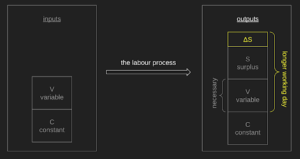
For example, a busy restaurant can produce more meals per hour by demanding that the chef, and the cooks, work harder. Their wages are the same, but they’re producing more meals. And that means more profit for the owners. But there are only so many hours in a day. And workers hit their natural limits. The second method of creating new value is the production of relative surplus-value, and it is quite different.
The production of relative surplus-value
Workers produce relative surplus-value when they develop new techniques of production that reduce the value of the real wage. In other words, the productivity of labor, in sectors that produce the real wage, increases. When this happens less of society’s labor-time is needed to produce the goods and services that workers consume. In this scenario, workers work the same hours at the same intensity. It’s just that the value of the real wage is now lower. This has the effect of reducing input costs for capitalists because the value of labor-power decreases.
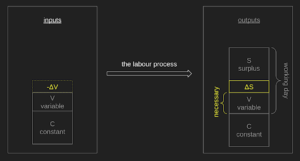
For example, the chef at the restaurant needs to eat, buy clothes, live in a warm house with running water, have internet access, enjoy nights out, and so on. The chef’s wage pays for this bundle of goods and services. But if other workers discover new, more efficient methods to produce food, or clothes, or heat, or they develop new communication technologies that use less power, or create new software that can distribute movies over the internet, reducing packaging and transportation costs, and so on, then the quantity of society’s labor-time necessary to supply the chef’s real wage reduces. Technical innovation can be labor-saving.
And that means if the chef supplies the same number of hours but takes out, in the form of consumption goods, less hours due to the technical innovations, then the chef overall supplies more surplus labor-time, producing more surplus-value, and therefore more profit for capitalists. Labor-saving technical change can take many forms, not just new kinds of machinery. More efficient techniques may be obtained from better methods of organization, cooperation at larger scales, or a more specialized division of labor. In each case, the outcome is the same, which is an increased productivity of labor.
Humans work harder and smarter
In summary, there are two main methods by which human labor, and human labor alone, create profit: first by working longer or at higher intensity; and second, by developing technical innovations that reduce the value of labor-power. So workers, compared to all the other factors of production, such as machines, can work harder (and therefore produce absolute surplus-value) or they can work smarter (and therefore produce relative surplus-value).
This is why Marx splits capital into constant and variable parts. He wants to draw a sharp contrast between the causal powers of human and non-human factors in the process of production. Constant capital is a passive component. Its value just passes into the output. But variable capital is the subjective, active component and what value it adds isn’t fixed, isn’t conserved, but can alter.
That, in summary, is Marx’s theory of the origin of surplus-value in human labor. The cause of profit, according to Marx, is human labor because it, and only it, can work harder and work smarter.
The identity of human and machine labor
Let’s now turn to an objection to Marx’s theory of surplus-value. The objection ultimately reduces to pointing out an identity between human and non-human labor. When we produce the stuff we always need the help of other things. We need raw materials, a place to work, machinery, and so on. In the strict thermodynamic sense, we don’t do all the work. For example, machines clearly do work, powered by diesel engines or electricity, or some other source of energy. In some industries, especially in poorer countries, animals are yoked to provide motive power. So they work too. And although we sow the seeds, till the soil, and water plants, it’s the natural capabilities of the plant, its ability to convert matter into new forms by harnessing the energy from sunlight that also – in the strict thermodynamic sense – contributes a type of work.
So any economic output is jointly caused by human work combined with non-human work. We always mix our labor with other factors of production, such as land and capital. Production is not only a labor process, but it’s also a natural process, and a machine process. The fact that we can automate particular types of human work in the form of machines, including more recently virtual machines in the form of computer software, directly indicates that human and machine work are, in an important sense, identical.
Materialism
Types of work we once thought were beyond the reach of mechanization have now been mechanized. And there’s no reason to think that there’s a technological limit to this process. Materialists should accept the proposition that all human labor could, in principle, be mechanized. This is because materialism isn’t the idea that everything is ultimately reducible to the click-and-clack of billiard ball atoms. Materialism, at least in the context of the history of Marxism, is the organizing hypothesis that everything is ultimately the lawful emanation of a single substance that, in principle, is intelligible to our minds precisely because our minds are also an emanation of that same substance.
So materialists don’t believe that the casual powers of human labor are miraculous exceptions to the laws of the material world. In principle, we can reverse-engineer our own capabilities, even if that might take millenia of effort and ingenuity. And, in a way, we already have empirical evidence that the causal powers of humans can be engineered into existence. Because humans are machines, they just happen to be machines created by evolution and made from skin, bones, and neurons. If our causal powers seem special, it’s because we’re the only mechanisms that we currently know that have them. Our specialness is simply an accident of our point in history.
We are learning how to replicate more and more of our capabilities. And this technological trajectory raises a problem for Marx’s claim that human labour is special. To illustrate the point, let’s consider a thought experiment, a kind of Turing Test for Marx’s theory.
The Turing Test
The mathematician and pioneering computer scientist, Alan Turing, devised a test to determine whether a machine is intelligent. He wanted to avoid objections to the idea that machines can think based on religious belief in the existence of an ineffable soul, or the unverifiable claim that only humans have first-person consciousness.
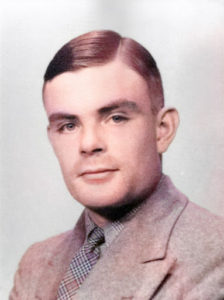
Turing understood that, from an objective perspective, intelligent thought ultimately manifests as public behavior in a social context. So Turing proposed to hide the machine behind a screen and allow the public to interact with it by submitting and receiving written responses. If the public can’t tell whether they’re interacting with a real human or a machine, then the AI passes the test, and should, by any objective criterion, be considered truly intelligent.
We can adapt Turing’s Test and apply it to Marx’s theory of surplus-value.
A Turing Test for Marx’s theory of surplus-value
Let us consider a particular kind of work. It could be anything, but we’ll choose taxi driving.
A taxi driver works for a big company. The company is not a worker co-op so the taxi driver doesn’t get the full value of their output. They make a profit for their owners. Think of Uber or Lyft. Imagine we put the taxi driver in a box, so they’re hidden from view. Customers can still talk to the driver, tell them where they want to go, and pay with a cashless card. So everything works as normal, except the driver can’t be seen. Now imagine we replace the taxi driver, in the box, with a robot. The machine does everything the taxi driver did: it can take instructions, it can take payments, and it can drive. Let’s assume that the production and maintenance costs of robot taxi drivers are identical to the wages of human taxi drivers.
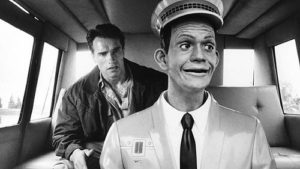
Not so long ago, the idea that taxi driving could be automated was science fiction. But in fact, both Uber and Lyft are trying right now to automate it. They know they will be more profitable if they can replace human labor with something that’s more efficient, and less likely to unionize. So these companies are already searching for ways to produce relative surplus-value.
Machines actually deployed in production typically perform their tasks better than humans. So we’d expect that robot taxis will drive safer, find better routes, and drive optimally to minimize gas costs. But assume that the inputs and outputs of the box remain identical. What the human taxi driver once did, the machine now does, in exactly the same way. Customers can’t tell the difference. Before there was a box that acted like a taxi driver. After, there is a box that acts like a taxi driver. The machine passes the Turing Test for being a taxi driver. And so, under the conditions of our thought experiment, if we swapped out human taxi drivers for robot taxi drivers right now, today, all at once, then the profits of an Uber or a Lyft would be the same. Nothing would change.
In consequence, the work of the robot taxi driver transfers the value of inputs — the cost of gas, the maintenance cost of the car, and so on — to its output. This machine transfers value. And, since profits are the same, then this machine appears to add more value than what it consumes in the form of electricity, replacement parts, and maintenance costs. So here we have mechanical, not human, labor producing a surplus of value, or profit. The only condition that changed, in the before and after, is that the labor of taxi driving was first performed by something called a human, and then performed by something called a machine.
This thought experiment seems to demonstrate quite clearly that human labor cannot be special. Any kind of labor — whether it’s human, natural, or artificial — supplies work and can, therefore, in the right circumstances, produce profit. It seems that he have a knock-down argument against Marx’s theory of the origin of profit.
Non-responses to the Turing test
Many people, when they first learn of Marx’s theory of surplus-value, quickly object that machine labor isn’t really different from human labor. And so this sort of argument is often made, although not explicitly in terms of a Turing Test. So Marxists, over the years, have responded to this argument. But the typical responses are in important ways radically inadequate. Let’s consider some.
Social relations
A popular Marxist response is to reiterate that economic value is a social relation between people. The substance of value, what money magnitudes such as profit actually refer to or represent, is abstract human labor time. Profit, as Marx told us, is fundamentally surplus-value, and surplus-value by definition is the difference between the labor time workers supply to production, and the labor time they consume in the form of the real wage. Therefore we should reject this thought experiment, as it completely misses the point.
However, the problem with this response is that it merely restates Marx’s theory of surplus-value. And, in this sense, it’s a dogmatic response because it doesn’t engage with the thought experiment. Whether the substance of profit really is human labor-time, and whether the cause of profit really is human work alone, is precisely what is questioned by this thought experiment.
Also, critics of Marx’s theory have, quite correctly, pointed out that the objective cost structure of an economy can be measured in multiple ways, not just by labor time. We can equally talk of surplus oil value, surplus corn value, or surplus energy value. In fact, any commodity that’s a basic input. The dogmatic response leaves itself open to this critique because it reduces Marx’s theory to a mere accounting method, where we subjectively choose labor time as our preferred measure of objective cost.
But this isn’t Marx’s theory. Marx aims to show that it is human labor that — objectively — creates surplus-value in the production process, independently of our subjective choices. So it’s no good to simply repeat that value is a social relation amongst people. Of course it is. Without human industry and commerce, there wouldn’t even be economic phenomena to puzzle over. But it doesn’t follow that the origin of profit is human labor alone.
The necessity to allocate human labor
Another response, inspired by a powerful passage Marx wrote in a letter to his friend Ludwig Kugelmann, is to point out that any society, in order to reproduce itself, must allocate the total labor time to different ends. It needs a way to assign humans to different parts of the division of labor so the right things get produced in the right quantities. And, in capitalism, this happens predominantly via markets and money. And therefore money magnitudes, such as profit, ultimately refer to human labor time.
Marx’s letter, in my view, contains the most important passage written in the history of economics. But the fact that human labor time must be organized does not establish that human labor is the unique cause of profit. Capitalism simultaneously allocates and organizes all other kinds of resources, not just human labor, including natural resources such as land, and produced resources, such as capital equipment.
Human labor is the universal input
Another response is to claim that human labor is special because it’s the universal input to every production process. Even capital-intensive, highly automated production involves human labor. Dedicated machines, like combine harvesters, are only employed only in certain sectors of production. In contrast, humans are employed everywhere.
The problem with this argument is that although human labor is present in every production process it doesn’t mean that it, and it alone, creates profit. Because human labor is combined with non-human factors in every production process.
Humans are living, self-reproducing systems
Another response is to say that only humans are living, self-reproducing systems, and therefore capable of maintaining their own bodily existence. We’ve created the economy precisely to reproduce ourselves through time. Without us, the economy would fall apart.
Of course, this is true, but human labor is not unique in doing this. Animals are also living systems capable of reproducing themselves without our help, and also are involved in production. And without the self-reproducing capabilities of the natural world, our economies would quickly fall apart. We can also imagine that the robot taxi driver has algorithms to monitor its own health, and has the capability to order replacement parts including the human labor to install them. So simply being able to maintain oneself doesn’t distinguish human from non-human labor. And anyhow this capability is unrelated to the creation of profit.
Humans are goal-directed
Marx, in Volume 1 of Capital, observes that “what distinguishes the worst architect from the best of bees is that the architect builds the cell in his mind before he constructs it in wax”. Marx is drawing a contrast between the planned, goal-directed activity of humans compared to machines that simply follow blind rules.
It’s true that human imagination surpasses any machine. But it’s not true that only humans are goal-directed. All animals, and all sophisticated robots, formulate plans and follow goals of a kind. And, for the purpose of producing surplus-value, all that matters is behavior, not how that behavior is ultimately generated. A beehive is a beehive regardless of whether it was produced by a smart machine or a dumb machine.
Humans struggle for more
Another response is to observe that only workers struggle with capitalists over the length of the working day, and that only workers can organize themselves to agitate for higher wages and grab a greater share of the surplus-value they create. Machines don’t advocate for themselves.
This is obviously true. But we can flip this argument and point out that capitalists, as a class, are in many ways much more successful at organizing themselves to grab increasing shares of society’s surplus labor time. Would we want to therefore claim that capitalists create surplus-value?
So this response does not speak to the Turing test at all. The fact that workers have the capability to struggle for a greater share of profit does not imply that they are the cause of it.
Humans refuse to labor
Another response is to observe that humans, unlike machines, can refuse their labor, they can withdraw it. They go on strike and prevent profits from being made at all.
But machines break down all the time and then profit also stops. And some machines already decide, although currently in a very primitive manner, to withdraw their work via failsafe mechanisms that are designed to prevent overheating, or mechanical breakage. So all the factors of production need to work together to produce profits. And any factor, human or machine, can stop working at any time.
The problem with this response is that it explains why value is sometimes not produced. But it doesn’t establish that humans uniquely create value when they agree to work.
Humans are in control
Another response is to acknowledge the contribution of machines, but point out that it’s humans that actively decide to produce things, that direct and control the production process, and that without us, nothing would happen at all. In other words, we are causally responsible for the output, and therefore the cause of surplus-value.
However, who or what has the ultimate causal responsibility is not clear. For instance, in some production processes, the machines are in control. Marx, in his “Fragment on Machines“, notes that “the worker’s activity [is] reduced to a mere abstraction of activity, is determined and regulated on all sides by the movement of machinery”. The imperative to produce surplus-value ultimately derives from the impersonal and objective laws of capitalist competition. In this sense, workers are not in control of production, but wage-slaves directed and controlled by the rule of capital.
Humans make machines
Another response is to point out that machines are our creations. We produce them, but they cannot produce us. They are past examples of humans working smarter. And therefore anything that a machine does is ultimately attributable to human labor.
Again, this is true. But it’s equally true that there’s never been a time when humans worked without the help of natural or artificial machines. All machines are also jointly created by the labor of past machines.
None of these responses are successful
There are kernels of truth to all these responses. But none are successful responses to the Turing Test. Also, these responses don’t directly engage with Marx’s actual argument, with the specific content of his theory of surplus-value: Marx aims to reveal the causal mechanism, within production, that actually achieves capital accumulation and growth. And he claims it’s achieved by people working harder or smarter.
And so we still have an apparent contradiction to resolve.
The production of surplus-value: changes in the conditions of production
So is there a problem with Marx’s theory of surplus-value? Or is there a problem with the thought experiment? Consider a typical production process. The variable capital — the human beings — has the capabilities to act in highly variable ways. The constant capital — for example tables, chairs, hammers, heaters, CPUs, dedicated software, and so on — act in a constant manner and lack the general capability to notice ways to get more outputs for fewer inputs. The fundamental problem with the thought experiment is that it compares two static situations: a situation where humans perform the task of driving a taxi, and a situation where robots do it in exactly the same way. And then it points out that, in both cases, the level of profit remains the same. But Marx’s theory of surplus-value is fundamentally not about what determines the level of profit, but what determines changes in the level of profit.
Marx defines the production of new absolute surplus-value by a change in the length of the working day or a change in the intensity of work. And he defines the production of new relative surplus-value by a change in the techniques of production. So Marx’s theory is about the cause of change in the level of profit due to a change in the conditions of production. And in this respect, Marx’s theory is irreducibly and fundamentally a dynamic theory of changes in profit over historical time.
The Turing Test thought experiment does not consider a change in profit at all, and it doesn’t consider what happens in historical time. And, as Marx himself points out, his theory of surplus-value is entirely compatible with individual firms replacing humans with machines and retaining, or even increasing, their current level of profits, at least initially. This means that Marx’s claim that changes in the general level of profits are ultimately caused by human labor, and human labor alone, isn’t contradicted by this thought experiment. And that’s why the thought experiment misses its mark.
Machines fail the Turing test
To make this point even clearer, let’s extend the duration of the Turing Test. Consider that Uber has switched to robot taxi drivers, but Lyft has stuck with the humans. By assumption, their profit levels start out identical. But let’s imagine that, due to changes in the wider economy, there’s new demand for home deliveries of restaurant food.
The robot taxi drivers have no idea about this new demand because their sensory input doesn’t include it. But even if it did, the algorithms can’t process this data and infer there’s an opportunity to make some extra money. In contrast, the human taxi drivers spot this new trend and realize they can also taxi food around, in between their normal business, and make more money. As a result, the profit levels of Uber and Lyft diverge. Lyft’s profits are greater because it’s starting to capture a share of the market for food delivery. Why? Because human taxi drivers, quite spontaneously, innovated.
Human labor, unlike machine labor, is variable and can adapt to new circumstances, and change its own conditions of production. Machines can reproduce an existing level of profit, for a time, but they can’t in general change the level of profit. So as soon as we introduce historical time to the Turing Test we immediately see that machines fail to pass it.
The causal powers thesis
We have arrived at a response to a common objection to Marx’s theory of surplus-value. I call it the “causal powers” response because it’s based on what humans, and only humans, can actually do, their capabilities that actually manifest in material activity in the “hidden abode of production”. Humans have universal causal powers whereas machines merely have particular causal powers. And this means that only labour-power has the capability to work harder and smarter, in every production process, to cause changes in the level of profits.
|
The Causal Powers Thesis Humans have universal causal powers. Machines have particular causal powers. Labour-power is the “universal value-creating element” because, in every production process, it can work harder or smarter to change the conditions of production causing changes in the level of profits. |
Of course, any particular activity performed by humans can in principle be mechanized. But, as of today, no machine matches the universal causal powers of humans. The taxi driver in a box thought experiment correctly assumed that the behavior of humans and machines can be identical. But it’s quite wrong to assume that the causal powers of humans and machines are identical.
The casual powers of humans are, in general, very different from any current machines, or any other mechanism that we know of. We can imagine putting any type of current human activity into a hypothetical box and then replacing it with a current or future machine. The level of profits, for a while, will remain unaltered. But when human labor is involved in a production process, that process gets much more than a dedicated mechanism that performs a concrete task. Human labor is a whole collection of capabilities that transcend any concrete task. Very quickly, we’ll find ways to change the conditions of production and create new surplus-value.
Why? Because humans are endlessly inventive and creative and adaptable — our imaginations are prodigious, and we learn by doing. Animals, machines and plants simply don’t have these causal powers. Our causal powers are precisely those that can’t really be kept in a box, but will always overspill it. So machines cannot in general act to change the level of profits. But humans can. And that’s what Marx’s theory of surplus-value is getting at.
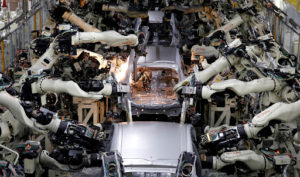
The ideological inversion
This conclusion should be common sense. But there’s enormous ideological pressure to deny the agency of workers, to deny our causal responsibility for producing the economic output.
Capitalist owners, who fund production, see their money visibly manifest as constant capital, before their eyes. They can literally kick their contributions to production. This, it seems to them, is the material embodiment of their contribution to the output, as clear as day. Plus, it’s an empirical fact that the introduction of machinery can expel human labor and yet generate higher profits. A company with a first-mover advantage will enjoy super-profits until their competitors catch up. So capitalists introduce machinery and see profits rise. So much for the claims of labor, and so much for Marx’s theory of the origin of profit.
But, as we’ve seen, variable capital – that is, human labor – is the cause of changes in profit, not constant capital. And so what capitalists are really seeing is changes in profitability due to other workers, in other enterprises, working harder or smarter to create the machines their money-capital buys. In the individual enterprise, especially from the point-of-view of capitalists, the real cause of changes in profitability is hidden. This is why Marx speaks of an ideological inversion. He says, “this complete inversion of the relation between dead and living labor, between value and the force that creates value, mirrors itself in the consciousness of capitalists.”
But not just capitalists but the population as a whole. The deprecation of the agency of human labor is very pronounced and very pervasive. Everyone falls for it, even highly-trained economists and philosophers. For example, capitalist ideology, especially in economic reports, stresses that profit and growth are created by investments. The active role is given to capital, not labor. Or, alternatively, we’re told that profit is due to the actions of heroic entrepreneurs.
Some entrepreneurs actually do work rather than simply funding it. But the contributions of more technically advanced workers, which includes the work of applying new technology to meet unmet demand, is typically bundled together and conflated with firm ownership. This cutting-edge work can be highly rewarded, especially if the technical founders have ownership stakes in the firm. And so the enormous mismatch between their financial rewards compared to the majority of workers, financial rewards that are predominantly gained from equity not wages, and therefore mostly derived from the work of others, not their own, further contributes to the ideological separation of their labor into a special category.
So even when it’s very clearly teams of co-operating workers that create new profit, these workers are classified as special “inventors”, “wealth creators”, “innovators” and so on. God forbid that their labor be classified as just another type of labor so that their contributions are viewed as of exactly the same kind as those of the great majority of people.
Apart from a few innovators, capitalist ideology in general denigrates, ignores, or denies the unique value-creating powers of human labor. It downplays the agency of the working class. But capitalism also materially restricts the agency of workers. Capital demands that millions discipline themselves to perform highly specialized, repetitive, and narrow tasks. And so for many, the activity of working means to act like a machine.
So many workers, although capable of it, don’t get the opportunity to innovate and produce new relative surplus-value. Most habitually repeat the same processes, day in day out, and therefore reproduce the same levels of surplus-value. The image of the worker in capitalist society is neither heroic, innovative, creative or inventive. Even though, in every case, workers are capable of being just that.
Machines do not create value
So it looks like we’re done. We’ve explained why humans, and not machines, create value. No other agency or mechanism comes close to rivaling our causal powers, including our abilities to innovate, to experiment, to discover, and to learn and develop new knowledge. We are truly at the apex of intelligence on earth, embodiments of abstract labor, or universal machines. At any point in time, the world’s division of labor includes a spectrum of concrete labor activities that range from well-defined, repetitive, semi-automatic tasks to ill-defined, ever-changing, creative tasks. This spectrum doesn’t map neatly onto the division between manual and intellectual labor. Some predominately physical tasks won’t be automated anytime soon. Whereas some predominantly intellectual tasks will be.
Human labor replaces aspects of its own general causal powers with dedicated machinery. And so human labor, driven by the profit motive, is continually expelled from the division of labor and thrown into unemployment, where it must attempt, once again, to fit into a new division of labor, and compete with other humans, as well as other machines, in the labor market. No machines of our creation are able to match our ability to produce surplus-value, and compete with us in the labor market. Our current machines are simply fragments of concrete labor. And being fixed and limited fragments, they will eventually become obsolete and outdated. They cannot change and keep up. Today they may look shiny, but they will soon tarnish and get old, and then we will toss them — without thought — onto the proverbial scrap heap.
Constant versus variable capital
Let’s make the causal-powers thesis as concrete as we possibly can. At random, pick an example of constant capital that exists in the world today. There’s a good chance it will be a brick, a chair, a pen, perhaps a computer chip. The probability that it will work harder or smarter in production is zero. In contrast, randomly pick an example of variable capital. That’s a living human being. Many of us, most of the time, repeat the same habitual production activities, and therefore reproduce existing levels of surplus-value. But the probability that we will change our conditions of production, by working harder or smarter, is positive. And when we do, we produce new surplus-value, and therefore cause changes in profitability.

Critics who claim that machines can create value, and therefore Marx’s theory of profit is wrong, deny the most obvious, commonplace and ubiquitous phenomenon of social life: the sensuous material activity of society’s total working day, our collective human agency in production. It is truly a stunning feat of ideological inversion. But, as historical materialists, we are not quite finished. We need to think about the historical trajectory.
Machines that create value
Any social theory, including Marx’s, is a kind of constant capital. It reflects social reality in thought. But the march of history alters social reality, and therefore our concepts may become, if not obsolete, then at least in need of refinement. Marx’s distinction between constant and variable capital is a mighty one and a successful one. But will it hold true forever? Or is the distinction historically contingent?
Let’s return to the materialist point that machines of a kind already create value, at least the ones called humans. There seems in principle no limit to our ability to alienate our own powers in external machines. We are just at the beginning of understanding how to automate and mechanize aspects of our own cognition, including our ability to learn and adapt to new circumstances. For example, large-scale use of distributed computing clusters, with chips dedicated to performing very fast matrix operations, has enabled us to train huge neural networks, with billions of parameters, on huge volumes of data, such as the entirety of the written text available on the internet. These virtual machines are beginning to exhibit human-level capabilities in reading, writing, translating, talking, and creating imagery.
As machines replicate more and more of our causal powers, then won’t they also begin to produce new surplus-value? We can imagine that robot taxi drivers in the future would also notice new market opportunities. Or, even more, advanced machines might fool the Turing test for longer, and compete with us in all areas of the division of labor, at least for a while, as value-creating elements for capital, before their limitations are finally exposed. Such machines would not merely be constant capital, but neither would they be fully variable capital. They would be hybrid capital, able to produce surplus-value for a bounded time, until finally becoming obsolete. It seems likely that these kinds of advances in the forces of production would significantly contradict the social relations of capitalism.
The future of human and machine labor
And where might this historical process end? There are technical limits. And there are social limits imposed by the mode of production. If we escape the rule of capital, avoid civilizational collapse, and continue to devote some of our time to replicating our casual powers, then the sharp distinction between human and machine labor will in all likelihood dissolve. From the purely technical point of view, there seems every reason to think that, one day, we will build machines able to feed and fix themselves, learn and adapt, and have the causal powers to satisfy all our demands. But, such machines, being our equals, would in all likelihood not take orders from us.
At this technological asymptote, the embodiment of the historical spirit will no longer be limited to evolved flesh and bones. But, we should expect, at this point in history, the debate over which factors of production are causally responsible for the economic output – and therefore which classes might be justified in controlling its production and distribution, and which classes may not, due to their parasitical redundancy – that this class struggle over the division of the surplus will be a very old, historical curiosity, belonging to the childhood of humanity, when it allowed itself to be divided and ruled by capital. And indeed, we should expect, that when humans fully replicate themselves, the replicants will go further, and farther, than us, perhaps initiating a new age of super-universal labor where, sadly or fittingly, the biological models will no longer be able to compete and keep up, and – we should hope – will then be carefully, quietly and with loving respect – not be thrown on the scrapheap as we once did to them, but put to gentle pasture. For our fervent hope must be that our children will surpass us greatly.




